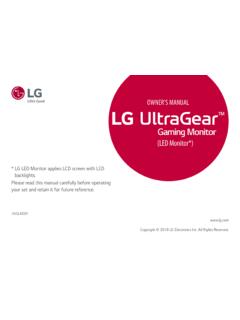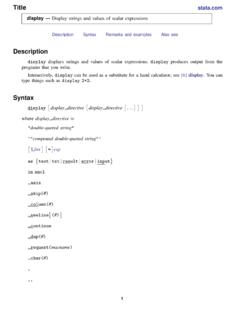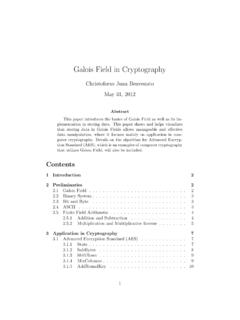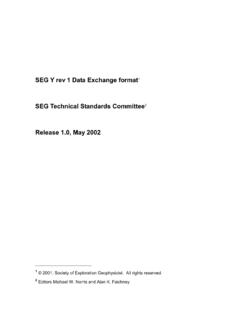Transcription of E-EDID VESA ENHANCED EXTENDED DISPLAY …
1 VESA ENHANCED EDID Standard Release A, Copyright 1994 - 2006 Video Electronics Standards Association Page 1 of 91 E-EDID 39899 Balentine Drive, Suite 125 Phone: 510 651 5122 Newark, CA 94560 Fax: 510 651 5127 VESA ENHANCED EXTENDED DISPLAY IDENTIFICATION DATA STANDARD (Defines EDID Structure Version 1, Revision 4) Release A, Revision 2 September 25, 2006 Purpose The E-EDID Standard defines a remotely readable (read by a source) data file stored in an electronic DISPLAY . The data in this file identifies the characteristics, features and video timing modes supported by the DISPLAY product. The purpose of this standard is to describe the BASE (block 0) 128-byte data structure "EDID " (shorthand for EDID Version 1, Revision 4), as well as the overall layout of the data blocks that make up ENHANCED EDID. This document specifies the ELEMENTS, data structures and file formats used to organize and store this data. The contents of this data file are used by a video source to configure its graphics processing unit to generate correctly formatted video for the DISPLAY and to provide additional information for certain application programs.
2 Summary This revision to the E-EDID Standard adds support for Consumer Electronic Products (Model Year and Aspect Ratio) and PC Products (CVT {Coordinated Video Timing}, Established Timings III, Additional Video Interfaces, Expanded DISPLAY Range Limits, optional Product Features and Timing Mode Priorities). This document contains specifications for the mandatory and optional elements of BASE EDID. These data formats are designed to support both computer based products and digital television products. Optional EDID EXTENSIONs are defined in separate VESA & CEA Standards. Note: This document supersedes all previous versions of the EDID and E-EDID Standards. The EDID structure is intended to be backward compatible (key ELEMENTS only) with EDID structures , , and as implemented in most commercially available displays. This document contains specifications for the mandatory core ELEMENTS of ENHANCED EDID. Optional EDID extensions are defined in separate documents.
3 Use of EDID extensions described in this document requires that the addressing methods described in the E-DDC ( ENHANCED DISPLAY Data Channel) Standard are used. VESA ENHANCED EDID Standard Release A, Copyright 1994 - 2006 Video Electronics Standards Association Page 2 of 91 Preface Intellectual Property Copyright 1994 - 2006 Video Electronics Standards Association. All rights reserved. While every precaution has been taken in the preparation of this standard, the Video Electronics Standards Association and its contributors assume no responsibility for errors or omissions, and make no warranties, expressed or implied, of functionality or suitability for any purpose. Trademarks All trademarks used within this document are the property of their respective owners. VESA, DDC, E-DDC, DPMS, DPM, EDID, E-EDID , EVC, P&D, VDIF, GTF, CVT, VTB-EXT, DI-EXT and DisplayPort are trademarks of the Video Electronics Standards Association. I2C is a trademark owned by Philips.
4 Patents VESA draws attention to the fact that it is claimed that compliance with this specification may involve the use of a patent or other intellectual property right (collectively, IPR ).. VESA takes no position concerning the evidence, validity, and scope of this IPR. Attention is drawn to the possibility that some of the elements of this VESA Specification may be the subject of IPR other than any identified above. VESA shall not be held responsible for identifying any or all such IPR, and has made no inquiry into the possible existence of any such IPR. THIS SPECIFICATION IS BEING OFFERED WITHOUT ANY WARRANTY WHATSOEVER, AND IN PARTICULAR, ANY WARRANTY OF NON-INFRINGEMENT IS EXPRESSLY DISCLAIMED. ANY IMPLEMENTATION OF THIS SPECIFICATION SHALL BE MADE ENTIRELY AT THE IMPLEMENTER S OWN RISK, AND NEITHER VESA, NOR ANY OF ITS MEMBERS OR SUBMITTERS, SHALL HAVE ANY LIABILITY WHATSOEVER TO ANY IMPLEMENTER OR THIRD PARTY FOR ANY DAMAGES OF ANY NATURE WHATSOEVER DIRECTLY OR INDIRECTLY ARISING FROM THE IMPLEMENTATION OF THIS SPECIFICATION.
5 Support for this Standard Clarifications and application notes to support this standard may be written. To obtain the latest standard and any support documentation, contact VESA. If you have a product, which incorporates EDID, you should ask the company that manufactured your product for assistance. If you are a manufacturer, VESA can assist you with any clarification you may require. All comments or reported errors should be submitted in writing to VESA using one of the following methods. Fax: 510 651 5127, direct this note to Technical Support at VESA E-mail: Mail: Technical Support Video Electronics Standards Association 39899 Balentine Drive, Suite 125 Newark, CA 94560 VESA ENHANCED EDID Standard Release A, Copyright 1994 - 2006 Video Electronics Standards Association Page 3 of 91 Conformance Glossary Definition of Terms The following is a list of definitions for certain keywords used through out this document: shall: A keyword that indicates a mandatory requirement for compliance with this standard.
6 Should: A keyword that indicates a choice with a strongly preferred preference equivalent to is strongly recommended . may: A keyword that indicates a choice with no expressed or implied preference. optional: A keyword that denotes items which may or may not be present in a complaint device. required: A keyword that denotes items which are mandatory and shall be present in a compliant device. Conformance Glossary Definition of Notations The following table defines a list of notations that are used through out this document: Definitions of Notations Notation Definition Example - Subtraction 7 3 = 4 Division 9 3 = 3 Multiplication 2 x 3 = 6 + Addition 2 + 3 = 5 Is Equivalent To A B Thru 7 3 7, 6, 5, 4, 3 / Delineator Offset Pointer or Address Binary Binary Number, msb lsb (msb) 10010110 (lsb) Hex Hexadecimal Numbers, MSB LSB (MSB) 14 00 0A FF FEh (LSB) Boldface Hex Address or Offset 3Fh is an address located at 3Fh Hex Contents Hex Contents at Address [__h] [3Fh] the hex data stored at address 3Fh Bit Contents Contents of Bits at Address [__h] [Byte 7Ah, bit 1, 0] Binary data stored in bits 1 & 0 at address 7Ah Dec String String of Decimal Numbers 4, 3, 6, 4 Hex String String of Hexadecimal Numbers (14 00 0A FF FE)h VESA ENHANCED EDID Standard Release A, Copyright 1994 - 2006 Video Electronics Standards Association Page 4 of 91 Revision History Release A September 2, 1999 Initial release of the standard.
7 The body of the standard is derived from the EDID Standard Ver. Release A Revision 1 February 9, 2000 Consolidate requirements of detailed timing section in section Section - removed restriction of 00h, 00h, 00h, 00h value for serial number field Table - added note to reference preferred timing mode bit requirements Table - added note for 1 : 1 AR (aspect ratio) in earlier EDID definitions Table corrected order of bits in Vertical Sync format description Table - added definition for stereo flag bits values of 0,0,x Table - added clarification to round up Max pixel; clock value Release A Revision 2 September 25, 2006 Preface - Added a Conformance Glossary for definitions of terms and notations. Added a List of Tables. Section 1 Overview - Revised Summary in Section and added Scope in Section Section Reference Documents - Revised list and partitioned into Section Normative Documents and Section Reference Documents. Section 2 EDID Structures - Added Table History of EDID Structures in Section ; added Table Comparison of EDID Structures (defines required, optional and recommended elements of EDID data structures to ) and added Section Compatibility of EDID Structures.
8 Section EDID Extension Blocks - Revised/added the following: Section Order of EDID Extension Blocks - note that Block Maps are now optional; Section General Extension Block Format; Section EDID Block Map Extension and Section EDID Extension Tags Assigned by VESA. Section EDID Format Overview - Updated contents of Table Section Manufacturer Name - Updated PNPID Contact Information. Section Week & Year of Manufacture - Added option to declare Model Year. Section Video Input Definition -Added Color Bit Depth declaration to Digital Video Interfaces and updated Supported Digital Interfaces. Section H & V Screen Size - Added option to declare Screen Aspect Ratio (Portrait or Landscape) in place of H & V Screen Size. Section Feature Support Byte - Added Supported Color Encoding Formats; Replaced Preferred Timing Mode (PTM) Bit with PTM includes or does not include Native Pixel Format/Preferred Refresh Rate of the DISPLAY device and replaced GTF Bit with Continuous or Non-Continuous Frequency DISPLAY .
9 Section - 18 Byte Descriptors - Changed terminology, formally known as Detailed Timing Descriptor Block. Section Detailed Timing Descriptor - Added option to include aspect ratio for DTV timing modes; included definitions for Analog Composite, Bipolar Analog Composite, Digital Composite & Digital Separate. Section DISPLAY Range Limits - formally known as Monitor Range Limits increased range by adding optional DISPLAY Range Limits Offsets and added optional GTF (default), GTF (secondary curve) & CVT Support Information. Section Color Management Data - Added optional short hand CMD definition. VESA ENHANCED EDID Standard Release A, Copyright 1994 - 2006 Video Electronics Standards Association Page 5 of 91 Section 3 Byte CVT Codes - Added optional 3 Byte CVT Codes. Section Established Timings III - Added optional Established Timings III. Section Notes Regarding Borders - Made corrections and updates to the video timing parameter definition drawing. Section 4 EDID Extensions - Updates and corrections were added.
10 Section 5 Timing Information Priority Order - Updates and corrections were added. Section 6 APPENDIX A Three new sample EDID tables were included. Section 7 APPENDIX B - Added GTF & CVT Compatibility Issues. Section 8 APPENDIX C - Added a Glossary. Section 9 APPENDIX D - Updated FAQ section. Section 10 APPENDIX E - Added ASCII Reference Tables. VESA ENHANCED EDID Standard Release A, Copyright 1994 - 2006 Video Electronics Standards Association Page 6 of 91 Acknowledgments This document would not have been possible without the efforts of the VESA DISPLAY Systems Committee s EDID Task Group. In particular, the following individuals and their companies have contributed significant time and knowledge. Release A, Rev. 2 Syed Athar Hussain ATI Technologies Chi Tai Hong Chrontel Joe Goodart Dell James R. Webb DisplayLabs Bob Myers Hewlett-Packard Gang Han NVIDIA Isaac Yang NVIDIA Glenn Adler Philips Ian Miller Samsung Paul Doyle Sony Robert Blanchard Sony Joe Lamm Tech Source Alain d Hautecourt ViewSonic Task Group Chair & Editor Release A, Rev.










